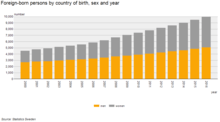Moroccans in Sweden
| Total population | |
|---|---|
| 9,945[1] | |
| Regions with significant populations | |
| Stockholm, Gothenburg, Malmö | |
| Languages | |
| Moroccan Arabic, Berber languages, Swedish, French | |
| Religion | |
| Predominantly Islam, minority Christianity |
Moroccans in Sweden are citizens and residents of Sweden who are of Moroccan descent.
Demographics

According to Statistics Sweden, as of 2016, there are a total 9,945 Morocco-born immigrants living in Sweden.[1] Of those, 3,099 are citizens of Morocco (1,597 men, 1,502 women).[3] As of 2016, 429 Moroccan citizens (361 men, 68 women) residing in Sweden are registered as asylum seekers.[4] Among these individuals are 144 Moroccan children out of a total 2,199 unaccompanied refugee minors residing in Sweden.[5] In 2016, the governments of Morocco and Sweden signed a treaty to facilitate the children's repatriation to Morocco.[6] According to Statistics Sweden, in 2016, there were 64 registered emigrations from Sweden to Morocco.[7]
Refugees
In May 2017 border police reported that false identities were common among Moroccan asylum seekers. Police in Sweden were able to verify the identities of 77 migrants from Morocco using fingerprint matches checked against the Moroccan fingerprint database. It was found that out of the 77, 65 had lied about their identity and of the 50 claiming to be underage, all but two were adult.[8]
Street youth
Of the estimated 800 street children in Sweden, Morocco is the most prevalent country of origin.[9] In 2016, the governments of Sweden and Morocco signed a treaty to facilitate their repatriation to Morocco.[10]
Education
As of 2016, according to Statistics Sweden, 26% of Morocco-born individuals aged 25 to 64 have attained a primary and lower secondary education level (23% men, 29% women), 35% have attained an upper secondary education level (37% men, 33% women), 19% have attained a post-secondary education level of less than 3 years (21% men, 17% women), 15% have attained a post-secondary education of 3 years or more (15% men, 15% women), and 6% have attained an unknown education level (5% men, 7% women).[11]
Notable people
- Loreen, singer
- Leila K, singer
- Kenza Zouiten, fashion model and blogger
- RedOne, producer and songwriter
- Said Legue, actor
- Nabil Bahoui, footballer
- Amin Affane, footballer
References
- 1 2 "Foreign-born persons by country of birth, age, sex and year". Statistics Sweden. Retrieved 20 January 2018.
- ↑ "Foreign-born persons by country of birth, age, sex and year". Statistics Sweden. Retrieved 20 January 2018.
- ↑ "Foreign citizens by country of citizenship, sex and year". Statistics Sweden. Retrieved 20 January 2018.
- ↑ "Asylum-seekers by country of citizenship, sex and year". Statistics Sweden. Retrieved 20 January 2018.
- ↑ "Number of children by sex, country of citizenship and year". Statistics Sweden. Retrieved 20 January 2018.
- ↑ "Nytt avtal med Marocko för utvisning av gatubarnen" (in Swedish). Omni. Retrieved 20 January 2018.
- ↑ "Immigrations and emigrations by country of emi-/immigration, observations and year". Statistics Sweden. Retrieved 20 January 2018.
- ↑ "Falsk identitet vanligt bland asylsökande från Marocko". SvD.se (in Swedish). Retrieved 29 May 2017.
|first1=missing|last1=in Authors list (help) - ↑ "Svensk-marockanskt avtal om gatubarn". Göteborgs-Posten (in Swedish). Retrieved 2018-01-20.
- ↑ "Nytt avtal med Marocko för utvisning av gatubarnen". Omni (in Swedish). Retrieved 2018-01-20.
- ↑ "The population 2016 by level of education, country of birth and sex. Age 25-64". Statistics Sweden. Retrieved 20 January 2018.
